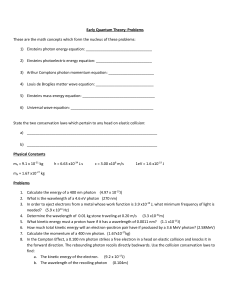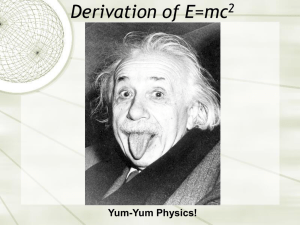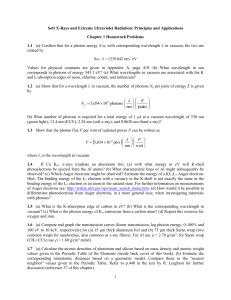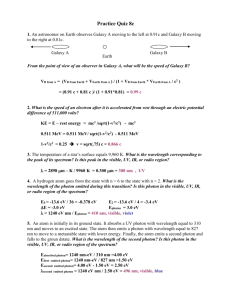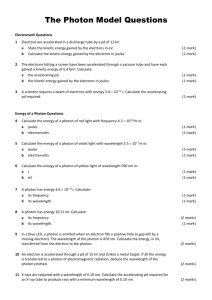NEW ECE THEORY AND APPLICATIONS TO PHOTON MASS
advertisement
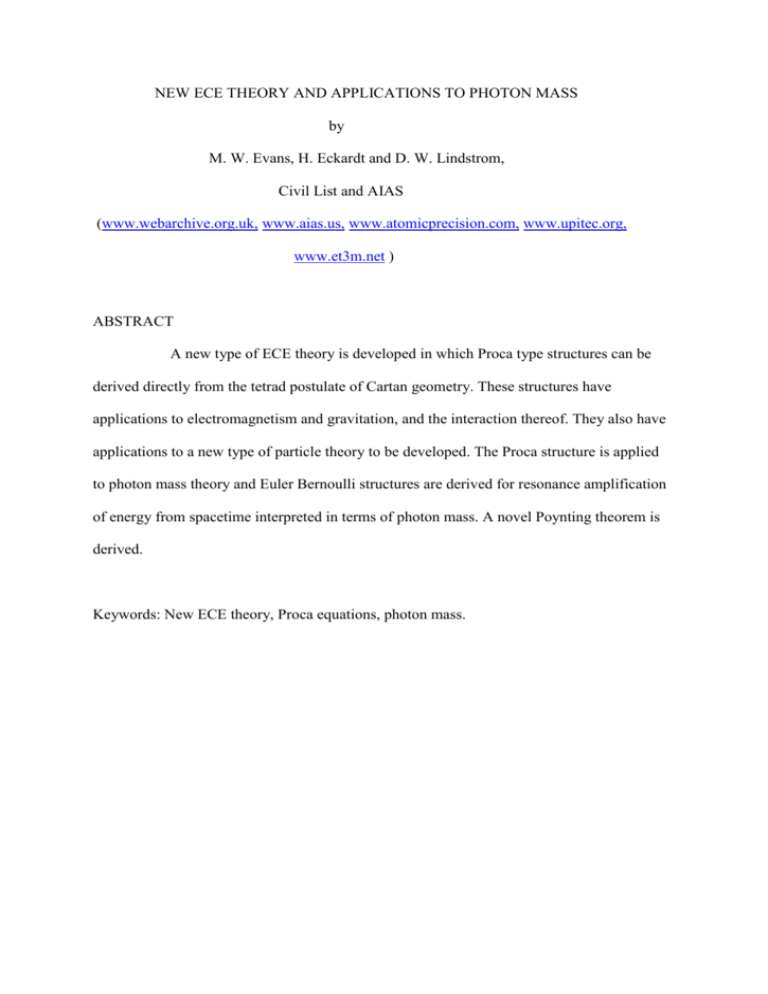
NEW ECE THEORY AND APPLICATIONS TO PHOTON MASS
by
M. W. Evans, H. Eckardt and D. W. Lindstrom,
Civil List and AIAS
(www.webarchive.org.uk, www.aias.us, www.atomicprecision.com, www.upitec.org,
www.et3m.net )
ABSTRACT
A new type of ECE theory is developed in which Proca type structures can be
derived directly from the tetrad postulate of Cartan geometry. These structures have
applications to electromagnetism and gravitation, and the interaction thereof. They also have
applications to a new type of particle theory to be developed. The Proca structure is applied
to photon mass theory and Euler Bernoulli structures are derived for resonance amplification
of energy from spacetime interpreted in terms of photon mass. A novel Poynting theorem is
derived.
Keywords: New ECE theory, Proca equations, photon mass.
1. INTRODUCTION
The Proca equations {1 - 10} were introduced in the mid thirties on the postulate
of photon mass developed mainly by de Broglie and his well known school of thought. This
school differs considerably from what is known as “standard” physics. Notably, the de
Broglie school adheres to finite photon mass, the “standard” physics asserts in a most obscure
manner that there is a particle without mass. Clearly, the concept of photon mass used by
both schools is naive. There is much more to photon mass than meets the eye. In this paper
the problem is analysed afresh in terms of a new type of ECE theory whose main advantage
is its ability to derive Proca structures directly from the most fundamental theorem of
geometry, the tetrad postulate of Cartan and his school of thought in mathematics. It is shown
in Section 2 that the tetrad postulate leads directly and elegantly to both the wave and field
equation of Proca. This result is true in electromagnetism and gravitation, and also in particle
theory, in which the Proca equation has been mainly applied. In “standard” physics the Proca
equation is ignored because it is not U(1) gauge invariant and effectively repudiates the
whole of Higgs theory. The latter is regarded by the de Broglie / AIAS school as
pseudoscience: the “cult science” of Feynman or “pathological science” of Langmuir. In
Section 2 it is shown that the new ECE theory is a well defined part of the original ECE of
2003 developed in this series of two hundred an forty five papers to date. A novel Poynting
theorem is derived and Euler Bernoulli resonance structures deduced. The photon mass is
defined in a novel way, and the Yukawa potential discarded as unphysical. The photon mass
means different things when derived from different experiments and different assumptions.
In Section 3 the novel Proca structures are developed in terms of the vacuum
theory of Eckardt and Lindstrom.
2. NEW ECE THEORY AND PROCA STRUCTURES.
In the original ECE theory of 2003 {1 - 10} the electromagnetic field tensor is a
vector valued two - form of Cartan geometry:
where A is the electromagnetic potential, a vector valued one - form, and where
is the Cartan spin connection. Eq. (
) is based directly on the first Cartan structure
equation with the hypotheses:
The new ECE theory of this paper defines the subsidiary electromagnetic field:
Consider the tetrad postulate of Cartan geometry {1 - 11}:
where
is the gamma connection and
the Cartan tetrad. Define:
and it follows that the tetrad postulate is:
Eq. (
) follows directly from the subsidiary postulate:
Differentiate both sides of Eq. (
) to obtain:
and define R as follows:
With postulates (
) and (
) Eq. (
It follows from the definition (
) gives the Proca field equation:
) that:
This is the 2003 ECE wave equation. With Eq. (
), Eq. (
) becomes the ECE
generalization of the Proca wave equation:
first derived in 2003.
It is seen that the Proca field and wave equations are subsidiary structures of the
more general nonlinear structure (
) of the first Cartan structure equation of geometry.
The B(3) field that is the basis of the ECE unified field theory is defined by:
and is derived from the nonlinear part of the complete field tensor (
). In the B(3) theory:
Now define for each polarization index a:
It follows {1 - 10} that:
This equation is the same as:
where the tilde denotes the Hodge dual. It follows that that:
which is the homogeneous field equation of the Proca structure. Note that Eq. (
) allows
the possibility of explaining the Aharonov Bohm effects with the assumption:
With this assumption the potential is non zero when the field is zero.
In UFT157 on www.aias.us the following relation was derived for each polarization
index a:
where the charge current density in S. I. Units is:
and where the four potential in S. I. Units is:
Here
is the vacuum permeability and
the vacuum permittivity. So:
and
where
is the charge density,
the scalar potential, J the current density and A the
vector potential. A list of S. I. Units is given as follows:
where E is electric field strength in volts per metre and B is magnetic flux density in units of
tesla. The complete set of equations of the Proca structure is therefore:
Now define the field tensor (
) and its Hodge dual as:
These definitions give the inhomogeneous Proca field equations under all conditions,
including the vacuum:
and the homogenous field equations:
under all conditions.
The solution of Eq. (
and from Eqs. (
so:
) and (
) is:
):
where:
Therefore:
The original Proca equations of the mid thirties assumed that:
where m is a rest mass. For electromagnetic fields in the vacuum this was assumed to be the
photon rest mass, so the Proca equations were assumed to be equations of a boson with finite
mass. More generally in particle physics this can be any boson. In Proca theory therefore the
electromagnetic field is associated with a massive photon (i.e. a photon that has mass). As
shown in this paper the massive photon is a direct consequence of the tetrad postulate of
geometry. Therefore the original Proca equations of the thirties assumed:
It follows that:
From Eqs. (
) and (
):
giving the photon rest mass as:
If it is assumed that the vacuum charge density is about the same order of magnitude as the
vacuum scalar potential, the order of magnitude of the photon rest mass is:
A list of experiments used to detect photon mass is given in ref. (12), and the result
(
) is in agreement with the experimental photon mass. So it is concluded that there
exists a vacuum charge current density which is about the same order of magnitude as the
vacuum four potential.
Conservation of charge current density for each polarization index a means that:
From Eqs. (
) and (
In the “standard” physics Eq. (
):
) is known as the Lorenz condition, an arbitrary
assumption. In the Proca theory the Lorenz condition is a direct result of the conservation of
charge current density, one of the fundamental conservation theorems of physics. In the Proca
theory the four potential is physical and so the U(1) gauge invariance of the “standard”
physics is no longer true. In consequence the Higgs theory collapses.
From the well known radiative corrections {1 - 10} it is known experimentally that
the vacuum contains charge current density. So it follows directly from Eq. (
) that it
must contain a four potential, the vacuum four potential associated with photon mass.
Therefore there are vacuum fields which in the non linear ECE theory of Eq. (
) include
the longitudinal B(3) field {1 - 10}. The latter therefore exists in the vacuum and is linked to
photon mass theory and Proca theory. In the “standard” physics the assumption of zero
photon mass means that vacuum fields are purely transverse. This is geometrical nonsense,
and leads to the unphysical E(2) little group as is well known {1 - 10}. So the “standard”
physics is unphysical. In consequence there is no Higgs boson. The vacuum four potential is:
It follows that a circuit can pick up the vacuum four potential via the inhomogeneous Proca
equations:
and
In this process total energy is conserved through the relevant Poynting theorem
derived as follows. Multiply Eq. (
) by E :
Use:
and Eq. (
) to find the Poynting theorem of conservation of total energy density:
The electromagnetic energy density in joules per cubic metre is:
and the Poynting vector is:
Eq. (
) defines the electromagnetic energy density available from the vacuum, more
accurately spacetime. This process is governed by the Poynting theorem (
) and therefore
there is conservation of total energy. There is electromagnetic energy density in the vacuum.
The relevant electromagnetic field tensor is:
so either:
or:
The antisymmetry of the Cartan torsion {1 - 10} means that the complete non-linear field of
Eq. (
) is antisymmetric:
The Cartan torsion is defined by:
where the antisymmetric torsion tensor
is defined by the commutator of covariant
derivatives:
The torsion tensor is defined by the difference of antisymmetic connections:
and the tetrad postulate means that:
It follows that the antisymmetry in Eq. (
If Eq. (
From Eq. (
so we arrive at:
) is defined by:
) is used for the sake of argument then the Poynting theorem becomes:
):
which shows that the vacuum energy density and vacuum Poynting vector are derived from
the time derivative of the vacuum current density squared divided by R.
In practical applications we are interested in transferring the electromagnetic
energy density of the vacuum to a circuit which can use the energy density. In an isolated
circuit consider the equation:
When the circuit interacts with the vacuum:
so the Proca equations become:
and
The Coulomb law is modified to:
and the equation governing the scalar potential is:
The d’Alembertian operator is defined by:
The time dependent part of
of the circuit is therefore defined by:
The most fundamental unit of mass of the circuit is the electron mass
frequency is defined by the de Broglie wave particle dualism:
So Eq.
(
) becomes:
which is an Euler Bernoulli resonance equation provided that:
The solution of the Euler Bernoulli equation:
is well known to be
At resonance:
, whose rest angular
and the circuit’s scalar potential become infinite for all A, however tiny in magnitude. This
allows the circuit design of a device to pick up practical quantities of electromagnetic energy
density from the vacuum by resonance amplification. The condenser plates used to observe
the well known Casimir effect can be incorporated in the circuit design as in previous work
by Eckart, Lindstrom and others.
From Eqs. (
) and (
):
If we consider the space part of the scalar potential
then:
and for each polarization index a the Proca wave equation reduces to:
The Laplacian in polar coordinates is defined by:
so there is a solution to Eq. (
) known as the Yukawa potential:
This solution was used in early particle physics but was discarded as unphysical. The early
experiments to detect photon mass {12} all assume the validity of the Yukawa potential.
However, the basic equation:
also has the solutions:
and
which are the well known Lienard Wiechert solutions. Here t
is the retarded time defined
by:
Therefore the static potential of the Proca equation is given by Eq. (
) with:
and the static vacuum charge density in coulombs per cubic metre is given by:
which is the Coulomb law for any photon mass.
This means that photon mass does not affect the Coulomb law, known to be one
of the most precise laws in physics. Similarly the photon mass does not affect the Ampere
Maxwell law or Ampere law. This is observed experimentally {12} within high
contemporary experimental precision, so it is concluded that the usual Lienard Wiechert
solution is the physical solution, and that the Yukawa solution is mathematically correct but
not physical. On the other hand the “standard” physics ignores the Lienard Wiechert solution,
and other solutions, and asserts arbitrarily that the Yukawa solution must be used in photon
mass theory. The use of the Yukawa potential means that there are deviations from the
Coulomb and Ampere laws. These have never been observed so the “standard” physics
concludes that the photon mass is for all practical purposes zero. This is an entirely arbitrary
conclusion based on the anthropomorphic claim of zero photon mass, an invalid, circular
argument. The theory of this paper shows that the Coulomb and Ampere laws are true for any
photon mass, so the latter cannot be determined from these laws. In other words these laws
are not affected by photon mass in the sense that their form remains the same. For example
the inverse square dependence of the Coulomb law is the same for any photon mass. The
concept of photon mass is not nearly as straightforward as it seems, for example UFT244
shows that Compton scattering when correctly developed gives a photon mass much different
from Eq. (
). There are unresolved questions in particle physics, because UFT244 has
shown violation of conservation of energy in the basic theory of particle scattering.
3. VACUUM THEORY OF ECKARDT and LINDSTROM.
ACKNOWLEDGMENTS
The British Government is thanked for a Civil List pension and the staff of AIAS
for many interesting discussions. Dave Burleigh is thanked for posting, Alex Hill for
translation and Robert Cheshire and Alex Hill for broadcasting.
REFERENCES
{1} M. W. Evans Ed., “Definitive Refutations of the Einsteinian General Relativity”
(Cambridge International Science Publishing, CISP, www.cisp-publishing.com, 2012),
special issue six of ref. (2).
{2} M. W. Evans, Ed., Journal of Foundations of Physics and Chemistry, (CISP 2011).
{3} M. W. Evans, S. J. Crothers, H. Eckardt and K. Pendergast, “Criticisms of the Einstein
Field Equation” (CISP 2011).
{4} M .W. Evans, H. Eckardt and D. W. Lindstrom, “Generally Covariant Unified Field
Theory” (Abramis 2005 to 2011), in seven volumes.
{5} L. Felker, “The Evans Equations of Unified Field Theory” (Abramis 2007, Spanish
translation by Alex Hill on www.aias.us)
{6} M .W. Evans and S. Kielich, Eds., “Modern Nonlinear Optics” (Wiley Interscience, New
York, 1992, 1993, 1997, 2001) in six volumes and two editions.
{7} M .W. Evans and L. B. Crowell, “Classical and Quantum Electrodynamics and the B(3)
Field” (World Scientific, 2001).
{8} M. W. Evans and J.- P. Vigier, “The Enigmatic Photon” (Kluwer, Dordrecht, 1994 to
2001) in ten volumes hardback and softback.
{9} M. W. Evans and A. A. Hasanein, “The Photomagneton in Quantum Field Theory”
(World Scientific 1994).
{10} M. W. Evans, H. Eckardt and D. W. Lindstrom, papers and plenary on ECE theory in
journals of the Serbian Academy of sciences, Found. Phys. Lett. and other journals.
{11} S. M. Carroll, “Spacetime and Geometry: an Introduction to General Relativity”
(Addison Wesley, New York, 2004).
{12} L. C. Tu, J. Luo and G. T. Gillies, Rep. Prog. Phys., 68, 77 - 130 (2005).



